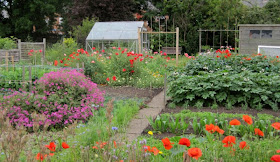When I first took over this plot twelve years ago it had been vacant for some years and was fast returning to the how nature intended - brambles and young ash seedlings were making the beginnings of primary temperate rainforest. So I can't take the credit for the hedges around two sides of my boundary which in places are thickets of blackberry and dog roses up to three or four metres deep. Together with the trees - elder, hawthorn, holly, horse chestnut and ash - they make good cover for the birds for nesting and feeding. I see and hear all of the common garden birds as well as the endangered song thrush which nests here up in the tangle of dog roses. I leave any fallen or standing dead wood to decay in it's own sweet time and add piles of logs and brash as homes for hedgehogs and any other creatures which see fit to use them. The foxes lurk about here too; they make a nuisance of themselves scratting about in my crops from time to time but no doubt they were here long before I was. At this time of year much of the whole is smothered by the twining stems of bindweed, whose pure white flowers are enjoyed by night-flying moths. Wildflowers such as rosebay willowherb, thistles and mallow add to the jolly melee. Not forgetting the nettles which are so important for the butterflies and their caterpillars. To all this I've added hawthorn, rowan, amelanchier and cherry plum.







The trees and hedgerow merge into the grasses and flowers of the orchard, mimicking the features of a woodland edge (the ecotone, to use the scientific parlance). Since planting out the ox-eye daisies in the orchard I've left most of the grass to grow long with just a couple of paths mown through - many butterfly caterpillars rely on grass species to feed on before emerging as adults in July and August. Some parts of the orchard are shady and others open - one area in particular I had to take out some plum tree suckers which were taking too much light from the growing areas and I now like to think of this area as my sunny glade. Since I've stopped mowing the grasses and wildflowers that were already there have been able to reach their full potential - amongst them self-heal, buttercup and clover - all much appreciated by the bees and butterflies.





In the growing areas the meadow and cornfield mixtures which I sowed last year have spread themselves around a little further and I've added to them here and there. These together with the green manure plants that I've left to flower are buzzing with bees throughout the day, and it's where I always start mine. I'm also slowly adding to my collection of beneficial herbaceous perennials to provide as much pollen and nectar throughout the year.










For as long as anyone can remember this area has also been a magnet for migrating swifts who make their nests under the eaves of the old tape factory just over the road. And there's also the bats fluttering around at dusk - I've no idea where they roost but they must enjoy the profusion of night-flying moths.
All in all it makes life worth living.
And then some.
Great photos and your description bought everything to life. I love watching swifts dart around in the evenings - we don't often get them here. As you say these things make life worth living
ReplyDeleteOops forgot to sign out of my other google identity as JD above!
ReplyDeleteWow, those poppies are gorgeous.
ReplyDeleteAlthough I hate bindweed with every fibre of my being, I have to admit the flowers are very beautiful. When I've been lazy and allowed one to actually set flower (ahem), it breaks my heart a bit to pull it out.
But hey, I get over it.
Hi Arabella, glad you liked it. I usually let the pictures tell the story but in this case I thought it was time to string a few words together.
ReplyDeleteHi Soilman, I'm lucky to have enough space to let the bindweed have its way in places on my plot although I don't give it any room in my growing areas. It took me a long time to get rid of it when I first took on my plot which I found a real bind. There I've said it.
I cant imagine how beautiful this is.
ReplyDelete